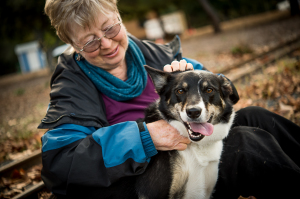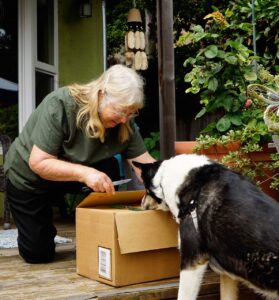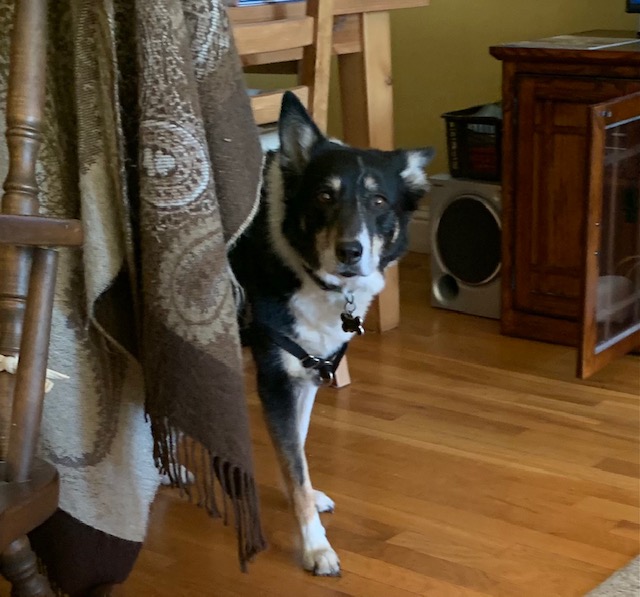 Kismet, my Border Collie, is lying on my feet. Since the pandemic, that is her favorite place to be while I write. My study is the warmest room in the house, and for most of her life, Kismet has spent the daylight hours there, sleeping on the soft rug under my large desk beneath the window. But now she sits on my feet.
Kismet, my Border Collie, is lying on my feet. Since the pandemic, that is her favorite place to be while I write. My study is the warmest room in the house, and for most of her life, Kismet has spent the daylight hours there, sleeping on the soft rug under my large desk beneath the window. But now she sits on my feet.
I prefer my laptop or tablet to my desktop computer for writing. I sit at a small table in the study crowded with reference materials, a lamp, headphones, my iPhone, and a cup of coffee. Once I settle into my chair, Kismet snuggles up beside me. Nothing too strange there. It’s kind of sweet and keeps my feet warm.
Pandemic Pup
What is strange – and new since the COVID-19 pandemic – is that whenever I rise from my work, instead of settling under the big desk while I stretch my legs, she follows me wherever I go. She follows me to the sink while I wash the dishes, to the garage while I load clothes into the washer. She stands and stares at me while I make the bed. If I don’t return to the study within ten minutes or so, she goes there herself and stands in the middle of the room barking until I return.
My Muse?
At first, I thought she was being a muse, encouraging me to write. I liked that idea. But now I believe she simply feels safer curled up beside me as I tap the keys in search of the perfect scene. In the last six months, we’ve gone from being buddies who saw each other mostly in the mornings and late at night to being the closest of friends, together 24 hours a day. And the more we are together, the less she wants to be apart. I assumed that following me from place to place was triggered by our new routine. But I had no proof.
Kismet is a Border Collie, as I’ve said. Dogs of this breed like a consistent schedule, and they need a lot of exercise. We’ve always walked in the morning after I feed her, but my schedule has relaxed since I’m no longer racing out the door to work. If I start clearing away the detritus of the previous day and forget to pour out her food, she will stand by her bowl and bark. Once she eats, she goes straight to the front door and waits for me to come and open it. She used to wait patiently by the door until I came. But now, if I don’t move fast enough, she barks until I come over and snap on her leash. An hour later, she’s back at the door again, barking to go on another walk. It’s almost as if she’s trying to get our old routine back. I used to leave for work after our walk. Perhaps if we go for another walk, I will leave, and the old world, the one she understood and felt safe with, will return?
I found myself feeling pressured into behaving in ways that brought Kismet comfort and made her feel safe. She wanted me to return to the study, so I returned to the study. That meant I was writing more, but neglecting my chores, sitting too long in one position, and writing beyond cognitive overload.
Then Kismet began running to the front door and barking several times a morning. Sometimes she announced the arrival of a package, but mostly it was a dog and its human walking down the street. Thinking she needed more exercise, I began taking her out two, three, even four times a day.
Then she started barking at my colleagues during Zoom calls. As soon as someone began to speak, Kismet would bark repeatedly. It got so bad that the administrator would remind me to mute my mike as soon as I joined the group. I began wearing headphones so she couldn’t hear the other participants. But once I joined a conversation, she’d start to bark.
Finally, I turned to the internet to see if I was the only one experiencing these new and annoying behaviors.
Pandemic Pet Behavior is a Thing
It turns out that pandemic pet behavior is a thing. As early as April 2020, journalist Michael Waters, writing for Vox, reported clingy dogs, cats “pouncing on exercise equipment, gliding across countertops or hiding in corners and shooting their owners concerned stares.”
Waters consulted Dr. Leanne Lilly, assistant professor of veterinary behavioral medicine at Ohio State University. She suggested that by being at home 24/7, owners had increased the number of interactions a day taking place between owners and their pets. Because so many people are bored from being contained in their homes all day, they began walking their dogs more often. I realized then that the increase in foot traffic outside my home was triggering Kismet’s alarm reflex, leading her to bark at every little noise, including the voices coming over my screen when I was on a Zoom call.
Dr. Lilly explained Kismet’s clingy behavior too. Pets, she said, just like children, can sense our moods and our psychological well-being. Fabricio Carballo, an animal cognition researcher at the University of El Salvador, published a paper in January 2020 reporting that dogs experience higher levels of anxiety when their owners are experiencing stress. Combining that with a disruption of typical schedules and the increase in togetherness caused by sheltering in place may result in what veterinary researchers call displacement behaviors. Those can include licking, biting, whining, barking, and – I suspect – hovering – when there seems no reason for those behaviors.
Extinguishing Pandemic Behavior in Pets
In August, Maura Judkis, a reporter for the Washington Post, described Miles, a small mixed-breed dog, who in April began barking at anyone wearing a mask. Miles’ human had worked closely with him when he was first adopted and understood how to deal with troublesome behavioral issues. With the help of two friends, she conditioned her pet to accept the masks on these familiar people, and eventually, he ignored mask-wearing strangers when they went on walks.
Tracy Krulik, a dog trainer and behaviorist in Northern Virginia, suggests the use of conditioning to extinguish other troublesome displacement behaviors. She’s working with Daniel Mills, a veterinary behaviorist and professor at the University of Lincoln in the UK, to study the long-term effects of the pandemic on dog behavior — particularly whether it creates separation anxiety in dogs that didn’t have it before. Meanwhile, she encourages people to get out of the house more, to help their animals get used to their absences in small doses. “If people can’t go back to work,” Krulik says, “go sit under a tree, go in your car, just get out of your house.”
The most important lesson I learned from reading the findings of these animal behaviorists is that Kismet is no weirder than other pets reeling from these confusing times. And there are solutions. I have started keeping a bowl of treats on my crowded work table. When Kismet barks I now command her to sit and lie down. When she settles, I give her a treat. It’s a small thing, but it’s a start.![]()
How are your pets behaving? Are you seeing these displacement behaviors? Please share your story in the Comments section.
* * * *
NOTE: This article appeared in a slightly different form in 60+Me Magazine.
Marlene Anne Bumgarner moved to the California coast when her first grandchild was born. The author of The Book of Whole Grains, Organic Cooking for (not-so-organic) Mothers and Working with School Age Children, her latest book is Back to the Land in Silicon Valley.
Share this post





Oh Yes, my life is so routine and predictable now that Sam is definitely the boss of me now. He lets me know when it is time to eat, take a walk, move from the chair to the bed, the bed to the chair. He doesn’t bark but puts a paw on me and looks at me very intently. Still this past year would be so much lonelier without his companionship. Kismet is such a sweet girl.
Hugs to you both..
Yes, Kismet is trying out the paw on my leg approach now that I’m ignoring her barking and treating her for being quiet. It’s much more effective than barking, which makes me cranky, and I think she’s figured that out.
Really liked this, Marlene. Fortunately (?) since the pandemic hasn’t changed my routine TOO much Mia hasn’t changed hers either, but I can sympathize with you nevertheless! Glad the research has paid off in dealing with the problems!
Update to previous comment: I spoke with my grandson today about his Siberian Husky, Sasha. Yes, her separation anxiety level has increased even though she’s almost never alone now. He said that when all 3 of them (his dad, sister and himself) are home, Shasa will find a spot to “rest” where she can see all of them…waiting to see who leaves. Otherwise, she follows whoever is home from room to room. Marlene, I was glad I was able to pass on some of what you shared. It was reassuring to him I believe.
Not having an indoor pet, we aren’t experiencing this first hand, but have heard from the grandchildren that their dog is definitely having an upswing in her anxiety.
Perhaps you could send them my essay so they understand what’s going on.
This is fascinating, Marlene. We don’t have a pet, so I can’t fully commiserate—but I was really interested to read this. It’s not surprising, I guess; pets are absolutely tuned in to their humans, maybe even codependently so! Sending Kismet some scratches behind her ears and a gentle belly rub.
Thanks for your kind words, Helen. I have passed on the ear scratches and Kismet says “Thank you, Helen!.”
My rescue cat has become clingy. Not a lap cat previously, I am now his pillow. Whatever room I am in, he is there. And he has taken to sleeping in the bed at night (before he was content patrolling night activity from the windows and napping in his favorite chair).
Excellent article. Thank you.
This is wonderful! Exactly what I’ve been reading about. Do you like having him on your bed? I feel safer at night, knowing Kismet is near.